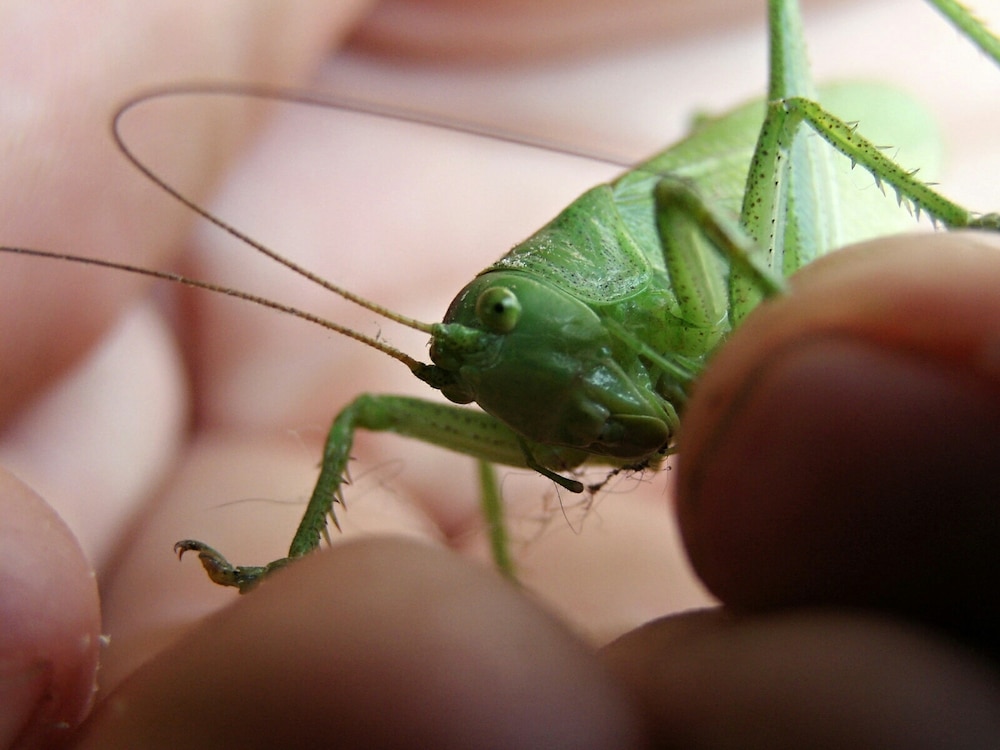Create a free profile to get unlimited access to exclusive videos, sweepstakes, and more!
Grasshoppers have mouths kind of like…ours?
Evolution does creepy things.

So maybe that princess in the fairy tale kissed a frog, not a grasshopper — but she would have realized something weird if she had gone in for a kiss with a grasshopper instead.
No, grasshoppers don’t have lips. What they do have are mouthparts eerily reminiscent of the differences in our own teeth (depending on what those teeth are used for). Some are more like molars, made to chew tough plant material so it becomes digestible. Others resemble incisors and are made for snatching up prey and tearing flesh. Evidently, not all of these creatures munch on the grass they crawl and leap through. Some are omnivorous or even carnivorous.
Finding out what grasshoppers eat used to mean either observing them in action — which is difficult when dealing with something that moves fast — or dissecting them to find out their stomach contents. Dissection can be problematic when dealing with specimens of species that might be rare or even extinct. Researcher Chris Stockey of the University of Leicester in the U.K., who led a study recently published in Methods in Ecology and Evolution, has found a better way.
“Dental topographic analysis measures the 3D shape of a food-processing tool, be it a tooth or in this case a mandible, similar to a map,” he told SYFY WIRE. “Different shapes reflect adaptations to different diets and these relationships are the same in most animals.”
When Stockey and his team compared the shapes of grasshopper mouthparts to mammalian teeth, they were able to tell which species ate what by comparing what was in their mouths to mammal teeth that were created for eating the same type of thing. Finding a match in the teeth of a mammal whose diet is known gives away what the grasshopper eats. Undulating surfaces, with a complex topography like that seen on molars, indicate the insect is into plants. Sharper mouthparts mean a craving for flesh. You could see these as your own molars and canines.
Though dental topographic analysis was actually developed for mammals, it can be used on any type of mouthparts that resemble mammal teeth and are used to process food before it is ingested. Using it on grasshoppers has now disproved some common assumptions about what they feed on. The researchers had already hypothesized what each species ate before they took a closer look. However, one thing that surprised them was that out of the 45 grasshoppers they studied, it was mostly the smaller species that hunted worms or other insects.
What could this possibly mean for the oldest common ancestor of extant grasshoppers? Unfortunately, insects are notorious for not fossilizing well, unless they are trapped in amber, but Stockey thinks there might have been herbivorous and carnivorous types going way back.
“The oldest grasshoppers are known from ‘molecular clocks’, or models that estimate when groups evolved,” he said. “However, a lot of their close relatives at that time were eating both plants and insects so I would imagine that they were also consuming both quite early on.”
Freakier than the resemblance of grasshopper mouthparts to mammalian teeth is that, about half a billion years ago, grasshoppers and mammals are thought to have shared a common ancestor. This obviously had to be before what would become vertebrates and what would become invertebrates diverged. When the researchers analyzed mouthparts, they saw what could have only been morphological adaptations that certain species had to develop in order to survive. When you have no control over what is around to eat, you adapt or you die out.
Being able to tell what grasshoppers ate through the structure of their mouthparts has saved some really fragile specimens. When you gaze at a display in a museum, what you may not know is that there are massive archives beyond the areas where visitors are allowed. Darwin’s entire collection is hiding somewhere behind the scenes. Using dental topographic analysis means all that remains of species that are now rare or extinct does not need to be destroyed to find out what they fed on and how that affected the environments they lived in.
“By analyzing their mouthparts with this technique, [we learn] about their diets, and most importantly incorporate them into broader analyses of how ecosystems function as a whole,” Stockey said. “In a way, we can bring them back to life.”


























